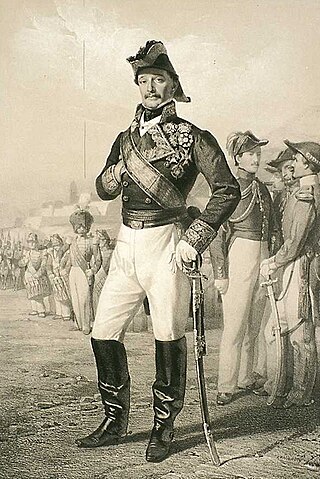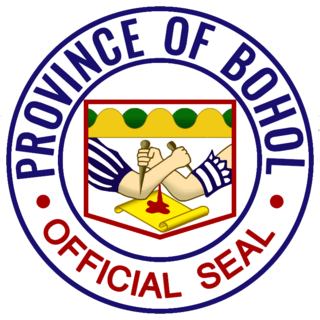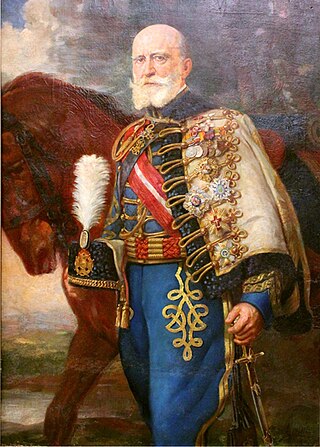
Oriente was the easternmost province of Cuba until 1976. The term "Oriente" is still used to refer to the eastern part of the country, which currently is divided into five different provinces.

Francisco de Asís was King of Spain as the husband of Queen Isabella II from their marriage in 1846 until Isabella's deposition in 1868. Francisco and his wife were double first cousins, as their fathers were brothers and their mothers were sisters. Isabella was deposed in the Glorious Revolution of 1868, but the monarchy was restored under their son Alfonso XII in 1874.

Antoine, Duke of Montpensier, was a member of the French royal family in the House of Orléans. He was the youngest son of King Louis Philippe of France and his wife Maria Amelia Teresa of the Two Sicilies. He was styled as the Duke of Montpensier. He was born on 31 July 1824 at the château de Neuilly and died 4 February 1890 at Sanlúcar de Barrameda, Spain.
José María Díaz de la Torre was a Spanish romanticist journalist, playwright, poet, and politician. His classic works are Julio César (1841), Lucio Junio Bruto (1844), Catilina (1856), and La muerte de César (1883). He also wrote under the pseudonym Domingo de Argote. He was also involved in the alta comedia.

Don Fernando Fernández de Córdova y Valcárcel, 2nd Marquess of Mendigorría, was a Spanish military, politician, and Prime minister of Spain for one day.

The Dominican Restoration War or the Dominican War of Restoration was a guerrilla war between 1863 and 1865 in the Dominican Republic between nationalists and Spain, the latter of which had recolonized the country 17 years after its independence. The war resulted in the restoration of Dominican sovereignty, the withdrawal of Spanish forces, the separation of the Captaincy General of Santo Domingo from Spain, and the establishment of a second republic in the Dominican Republic.

Juan de Zavala y de la Puente, 1st Marquess of Sierra Bullones was a Spanish noble and politician. After fighting in the First Carlist War, the Marquess served as Prime Minister of Spain.
Juan de Courten (younger) (1765-1834) was a Spanish general who led an infantry division during the Peninsular War against the First French Empire. In 1810, he was promoted to mariscal de campo, a Spanish rank between brigadier general and lieutenant general, and therefore equivalent to major general. The following year he was captured at the conclusion of the Siege of Tarragona. In 1818, he received an important military decoration.

The Sociedad Económica de los Amigos del País de la Habana or Real Sociedad Patriótica de la Habana is a learned society in Havana, Cuba. It was initially organized to promote agriculture, commerce, education, and industry, modelled on the Sociedad Económica de los Amigos del País in Spain. Founding members included Diego de la Barrera, Francisco Joseph Basabe, José Agustín Caballero, Luis de Las Casas, Juan Manuel O'Farrill, Tomás Romay y Luis Peñalver, and Antonio Robledo. In its early decades the group produced publications, maintained a library in the Convento de Santo Domingo (1800-1844), and arranged educational programs. Around the 1790s the group built the Hospicio o Casa de Beneficencia in Havana.
Zoilo Sánchez de Ocańa y Vieitiz was a Spanish Navy officer who served as the first Chief of Staff of the Navy from 14 July 1895 to 19 March 1896. As of 1869, he was a frigate captain on the war and navy section of the State Council. He was also made a Commander of the Order of Charles III in 1865, and in 1893 he had been awarded the Order of Naval Merit. It is likely that he was retired or died by the time the Spanish–American War broke out in 1898, as he was not present at a meeting of senior Spanish naval officers on 23 April 1898 that decided to send Admiral Pascual Cervera's squadron to Cuba.
Manuel Mozo y Díaz Robles was a Spanish Navy officer who served as the Chief of Staff of the Navy from 30 March 1899 until his death on 27 April 1902. Additionally, he commanded multiple different ships and squadrons, as well as serving as commandant of the Escuela Naval Militar. He himself entered the naval college at Cadíz in 1849. During the Spanish–American War, Mozo attended the 23 April 1898 meeting of senior Spanish naval officers chaired by Segismundo Bermejo y Merelo to discuss the dispatch of Admiral Pascual Cervera y Topete's squadron to Puerto Rico and Cuba. He stated that if the Government of Spain believed it was in the country's best interest, then he was in favor, otherwise he considered that it would lead to disaster unless his squadron was reinforced. He was awarded the Order of Naval Merit in 1897. As of 1895, he was a ship-of-the-line captain. He was a supporter of the Jeune Ecole French school of naval strategic thought, which he spoke of in his treatise on international maritime law.

José Marina Vega was a Spanish military officer and politician. Leader of the military operations in Melilla during the 1909 Melilla Campaign, he later served as High Commissioner of Spain in Morocco (1913–1915) and as Minister of War.

The Governor of Bohol is the local chief executive of the provincial government of Bohol, Philippines. The governor holds office at the Bohol New Provincial Capitol in Tagbilaran City and its official residence is at the Governor's Mansion located along Carlos P. Garcia Avenue in Cogon District, also in Tagbilaran. Like all local government heads in the Philippines, the governor is elected via popular vote, and may not be elected for a fourth consecutive term. In case of death, resignation or incapacity, the vice governor becomes the governor. Along with the governor of Cebu, city mayors of Cebu, Lapu-lapu, and Mandaue, the province's chief executive is a member of the Regional Development Council of the Central Visayas Region.

Salvador de Arizón y Sánchez-Fano (1853–1921) was a Spanish Lieutenant General who participated in the Cuban War of Independence and the Philippine Revolution. He was a member of the House of Arizón as well as the Directorate-General of the Civil Guard from June 26, 1917, to December 6, 1918.

Augusto Arango was a Cuban revolutionary and mambí General who was assassinated by Spanish authorities in Cuba during the Ten Years' War.
Juan de Lesca was a 19th-century Spanish military figure who was a Knight of the Grand Cross of the Order of Isabella the Catholic, fought in the Ten Years' War, and was later bestowed the Order of Saint Hermengild.
José de Valera was a high-ranking Spanish military figure who distinguished himself in Cuba's Ten Years' War.
Demetrio Quirós Weyler was a Spanish military officer notable for his service during the Ten Years' War in Cuba, where he later served as the governor of Matanzas.

José Morales Lemus was a Cuban revolutionary, merchant, and lawyer.
The Battle of El Salado occurred on January 7, 1869, during the Ten Years' War, near Salado River and the Salado settlement, in the municipality of Río Cauto, Granma Province, in Cuba.











